Abschlussarbeiten - Exp. Pflanzenökologie
Im Folgenden findest Du die Themenvorschläge für Bachelor- (BA) und Masterarbeiten (MA), nach ihrem potentiellen Startpunkt geordnet.
Themen können in den meisten Fällen an eigene Interessen angepasst werden und eigene Themenvorschläge sind immer wilkommen und können wenn erwünscht gerne mit unserer Unterstützung entwickelt werden!
Bei Interesse sprich uns einfach mal an!
Hier findest Du eine hilfreiche Einführung in das wissenschaftliche Arbeiten:
Wissenschaftliches Arbeiten im Rahmen von Seminaren & Abschlussarbeiten
Hier noch eine kurze Anleitung zur Installation von R:
Die AG „Experimentelle Pflanzenökologie“ schreibt für 2023/24 folgende Themen für B.Sc.- und M.Sc.-Arbeiten aus:
Development of a cattail cultivation and accompanying vegetation on an 8- hectare experimental field, five years after establishment (BA or MA)
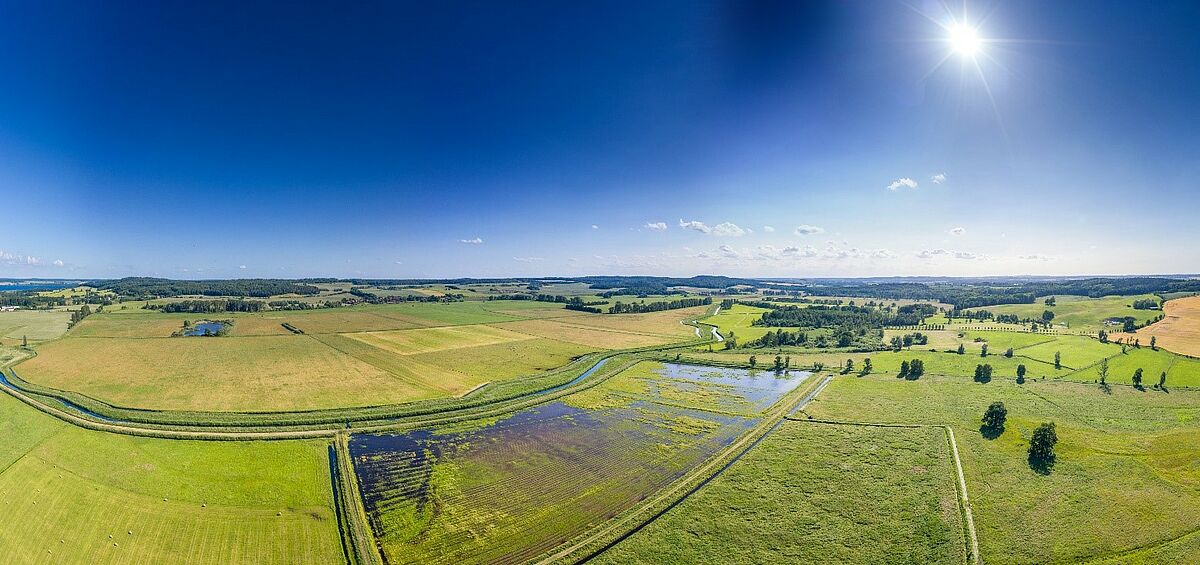
Time: field work in July 2024
Location: Experimental field near Neukalen
Contact: Nora Köhn (nora.koehn@uni-greifswald.de)
Introduction: To reduce greenhouse gas emissions, soil degradation and soil subsidence of drained peatlands, rewetting of these sites is urgently needed. An important question for farmers and society is how to keep these areas productive - especially for Mecklenburg-Western Pomerania, rich in fen sites. Paludiculture, as the productive use of wet and rewetted peatlands for example with the cultivation of suitable plants, is a promising solution.
Near Neukalen, a cattail (Typha spp.) field of approx. 8 ha was established in 2019, to investigate the cultivation of large-scale paludiculture on a rewetted peatland. The initial focus was to answer questions about e.g. the feasibility, economics, and biomass quality of cattail in the first years after establishment. Since 2022, a new project Paludi-PROGRESS (“Paludiculture in practice: Optimisation of cattail and reed cultures”) is testing and further developing the cultivation of cattail as a new permanent crop. Methods: In the first vegetation period, 80 plots were already established and vegetation surveys took place over the following years (2020-2023). In the 2024 vegetation period, we want to continue to monitor the development of the target species and its accompanying vegetation in the fifth year by assessing e.g. plant height, species composition and plant cover. Furthermore, we want to identify which influence environmental factors, such as the water table level, have. The data for the thesis will be collected during several days of fieldwork on the experimental field near Neukalen. Species knowledge of wetland plants is beneficial, but can also be acquired during the data collection.
Using historic and experimental data to predict future changes in leaf and flower phenology in trees of current and future generations. (BA/MA))
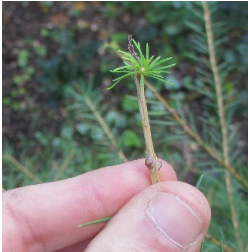
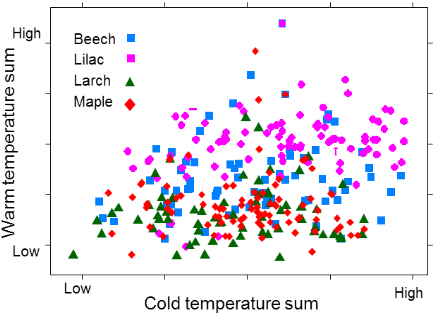
Timetable: flexible as no experimental work is necessary.
Contact: Dr. Andrey Malyshev, Prof. Dr. Juergen Kreyling
Background: warmer winter and spring temperatures have resulted in many tree species advancing their spring budburst. However, higher mean temperature does not always lead to earlier leaf-out and flowering, with species-specific shifts in spring phenology. Warmer winter results in an insufficient number of cold days which can cause some species to stop advancing or even delay the start of their growing season. Within species, genetic variation results in some species always starting to grow and flower earlier than others. It is important to forecast if early and late flowering trees will be able to cross-pollinate each other in the future to predict if the next generations of trees will be early or late growing/flowering. The goal of this data analysis is to a) use available phenology and climate data to evaluate which species is most likely to gain a competitive growth advantage in the spring and b) how flowering times of early and late flowering species may change and whether more early of late flowering trees are to be expected in the future generations due to flowering mismatches.
Methods: phenology and climate records from the last 30 - 60 years are available for several European countries and common tree species. The number of species, countries, climate parameters and years to be included in the analyses will be adjusted based on the project (Bachelors/Masters) and in-terest. Data will be obtained and organized from the German Weather Service and / or European phenology databases. The statistical program “R” will be the primary tool used to calculate climate indices and analyze the data.
Literature: Fu, Y. H., Piao, S., Vitasse, Y., & Zhao, H. (2015). Increased heat requirement for leaf flushing in temperate woody species over 1980 – 2012: effects of chilling, precipitation and insolation, 2687–2697.
Comparing phenology of beech saplings form different regions of Europe
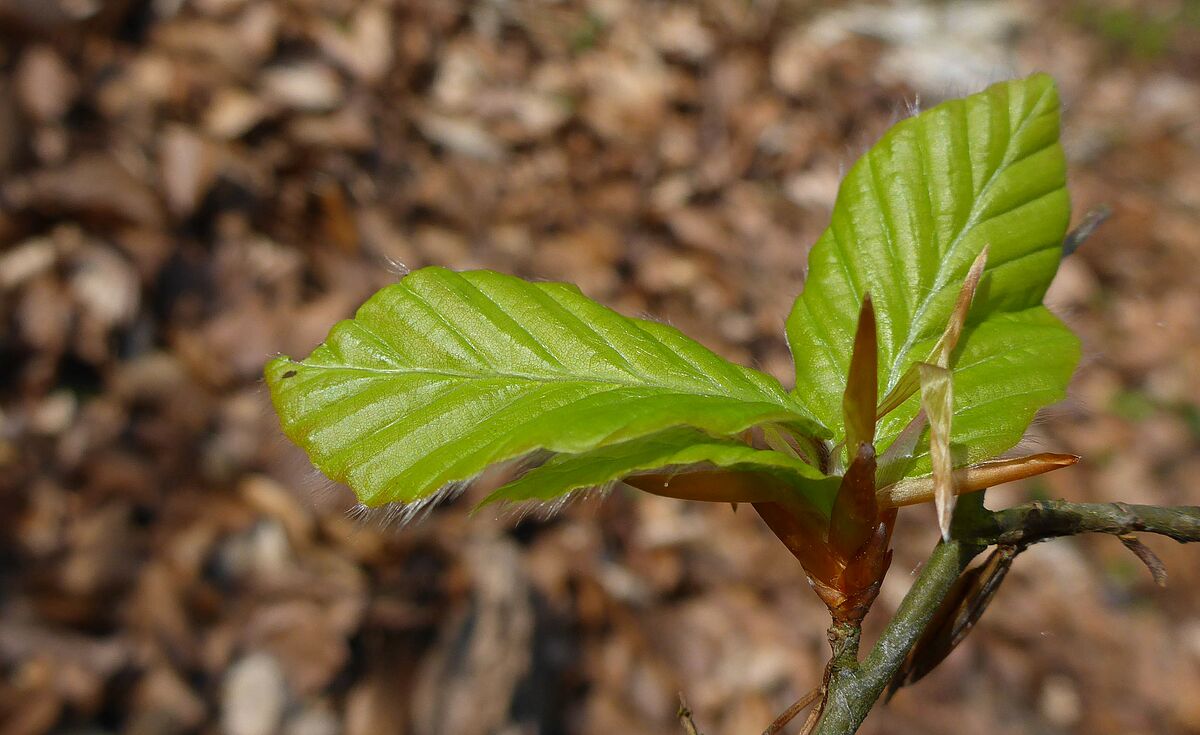
Time: growth: winter 2023/2024, spring phenology: end March - begin May 2024, autumn phenology: September - ca. November
Location: Forest near Hanshagen
Contact: Ilka Beil, ilka.beiluni-greifswaldde
Background:
Plants phenology is typically optimized in a way that the growing season is as long as possible while the risk of freezing is as low as possible. In a widespread species like Fagus sylvatica (European beech) one would expect that different ecotypes, developed in different regions of Europe, show some variation regarding spring and maybe even autumn phenology. If climate is now getting warmer and winters become shorter, plants with earlier leaf out strategies in spring and later autumn coloration might be at an advantage, because they have more time to grow over the year. An early onset of growth is even more important when the likelihood of summer drought is rising.
Methods:
We planted beech seedlings originating from different regions in Europe into the forest near Hanshagen following a randomized block design. After establishment in 2020 they are now ready for comparing the spring and autumn phenology as well as tree growth of the different provenances (ecotypes). In winter, we measure height and stem diameter. End of March until begin of May, spring leaf out will be observed 3 times a week and in autumn (September until November) leaf senescence will be assessed every week. You will be part of a research project, that investigates phenology and growth of beech provenances over many years. Are you interested in a bachelor or master thesis that might have interesting implications for forest management? Then this project might be interesting for you.
Paludi Progress - Optimierung von Schilf- und Rohrkolbenpaludikulturen
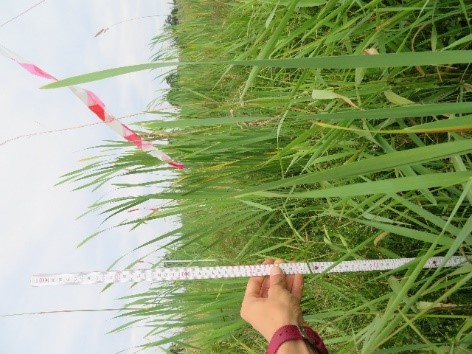
Zeitraum: ab Winter 2023/2024 (Dezember/Januar)
Ort: Greifswald (Flächen in Mecklenburg-Vorpommern)
Kontakt: Meline Brendel (meline.brendel@uni-greifswald.de)
Im Rahmen des Paludi-PROGRESS-Projektes gibt es die Möglichkeit, Abschlussarbeiten zu schreiben, die sich mit dem Biomasseauf- und abbau von Schilf- und Rohrkolbenkulturen beschäftigen. In Paludi-PROGRESS geht es um Paludikultur, also die landwirtschaftliche Nutzung (wiedervernässter) Moore, genauer gesagt um die Optimierung von Schilf- und Rohrkolbenkulturen. Der Biomasseauf- und abbau wird dabei sowohl in kontrollierten Mesokosmen-Experimenten als auch in Freilandversuchen untersucht.
Mögliche Themen könnten sein:
- Einfluss von verschiedenen Parametern wie Temperatur oder Wasserständen auf den Biomasseabbau von Rohrkolben ODER Schilf auf Paludikultur-Flächen in MV (Feldarbeit und Laborarbeit)
- Untersuchungen zum Einfluss von Wasserständen auf den Biomasseauf- und -abbau von Rohrkolben unter kontrollierten Bedingungen in Mesokosmen in der Mesokosmenanlage in Greifswald (Laborarbeit sowie Arbeiten in der Mesoksomenanlage)
- Eine Kombination der Themen ist auch möglich.
Beprobung von Dachreetbeständen in Vorpommern (BA oder MA)
Zeitraum: ab Sommer 2023 (Probennahme Januar/Februar 2024)
Ort: Greifswald (Flächen in Vorpommern, ggfs. Rügen, Usedom, Peene)
Kontakt: Nora Köhn (nora.koehn@uni-greifswald.de) und Sabine Wichmann (wichmann@uni-greifswald.de)
Hintergrundinformationen:
Die Reetdachdeckerei ist ein uraltes Handwerk (Immaterielles UNESCO Kulturerbe) mit hoher regionaler Bedeutung an den Küsten Norddeutschlands und in seenreichen Gebieten. Den Bedarf an Qualitätsschilf als Dachreet zeigt die derzeitige Marktlage, gleichzeitig ist die Ernte von Dachreet in Deutschland seit Jahrzehnten stark rückläufig und die Importrate liegt mittlerweile bei ca. 85 %. Die Gründe sind zum einen der Verlust von Röhrichten (Schilfgürtel) durch Deichbau, Entwässerung und Kultivierung von Feuchtgebieten und zum anderen ist die traditionelle Wintermahd der verbliebenen Gebiete durch Naturschutz-Vorgaben stark eingeschränkt. In Deutschland sind Qualitätskriterien für Reet als Dachdeckmaterial über die Fachregeln der Dachdeckung geregelt. Hier werden Maße, Anforderungen und Prüfungen beschrieben. Meistens beruht die individuelle Qualitätseinschätzung aber maßgeblich auf generationsübergreifenden Erfahrungen der verarbeitenden Betriebe. Die Eingrenzung und Vereinheitlichung der Qualitätsanforderungen können noch verbessert und die Erfahrungen der Handwerker (Rohrwerber*innen und Reetdachdecker*innen) müssen mit Literaturangaben verbunden werden. Insbesondere sind qualitätsbestimmende Standortfaktoren bzw. Wachstumsbedingungen zu identifizieren, um Empfehlungen für die Kultivierung von Schilf abzuleiten.
Methoden:
Die Durchführung der Abschlussarbeit soll sich in mehrere theoretische und praktische Teile aufgliedern, deren Ergebnisse im Anschluss sinnbringend in einer schriftlichen Ausarbeitung zusammengeführt werden müssen.
Sommer/Herbst 2023 (Vorarbeit)
- Recherche zu Qualitätsanforderungen und Untersuchungsparametern, ggfs. Befragungen von Praktikern.
- Besichtigung vorab ausgewählter Dachreetbestände, Aufnahme von Standortbedingungen (Begleitvegetation,
- Voraussichtlich Teilnahme an Expertenworkshop mit Rohrwerber*innen und Reetdachdecker*innen, u.a. zu den Themen Konkretisierung von Management- und Qualitätsanforderungen für Dachreet.
Winter 2024 (praktische Durchführung)
- Probennahme in den Dachreetbeständen, Probenbearbeitung hinsichtlich der recherchierten/bekannten Qualitätsanforderungen.
- Datenanalyse in Verbindung mit Standortbedingungen.Stratigrafie, etc.).
Wurzelphänologie von Rohrkolben (Typha spp.) und Biogeochemische Prozesse in Relation zu verschiedenen Wasserständen (mindestens 1 MA oder 2 BA)
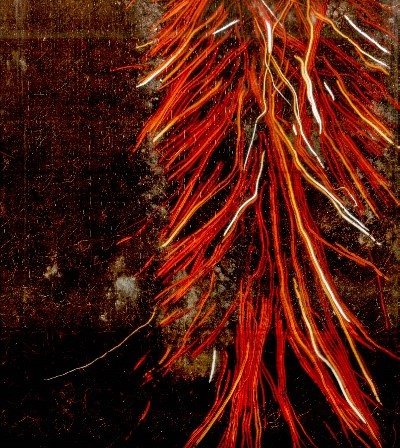
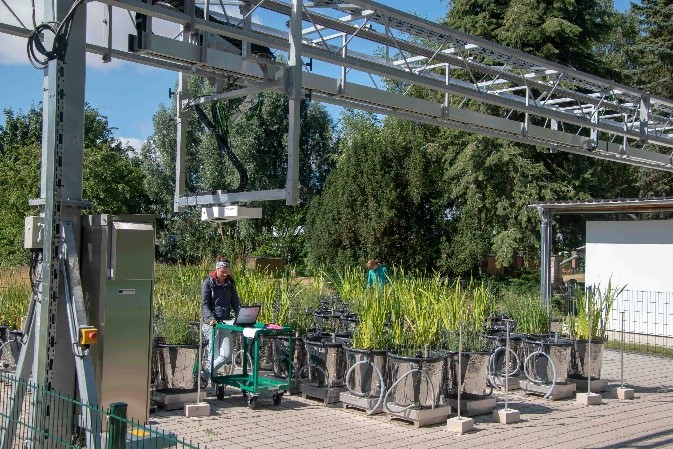
Zeitraum: ab Frühjahr 2024
Ort: Greifswald (Institut für Botanik und Landschaftsökologie)
Kontakt: Jürgen Kreyling und Meline Brendel (meline.brendel@uni-greifswald.de)
Pflanzenwurzeln haben eine Schlüsselrolle in den Ökosystemen und sind besonders wichtig in Niedermooren, wo die Wurzeln und Rhizome Torf bilden und somit große Menegen Kohlenstoff speichern. Es ist jedoch wenig über die Wurzeldynamik von Rohrkolben (Typha spp.) bekannst, z.B. wie die Wurzeln und Rhizome auf verschiedene Wasserstände oder Dürreperioden reagieren. Im Rahmen des Projektes Paldui-PROGRESS wird dies u.a. untersucht.
Im Rahmen des Projektes sind auf der Mesokosmenanlage der Universität Greifswald verschiedene Abschlussarbeiten möglich:
- Einsatz von Minirhizotronen (Wurzelkameras) in einer Mesokosmen-Anlage zur Bewertung des Wurzelwachstums und der Wurzelarchitektur der Niedermoorarten Typha angustifolia und Typha latifolia bei unterschiedlichen Grundwasserverhältnissen.
- Bewertung der Biogeochemie und der Gasflüsse, die bei unterschiedlichen Grundwasserständen in der Mesokosmos-Anlage entstehen.
Transpirationsmessungen auf einer Paludikultur-Pilotfläche (MA oder BA)
Zeitraum: Sommer 2024
Ort: Greifswald (Fläche bei Neukalen in Mecklenburg-Vorpommern)
Kontakt: Meline Brendel (meline.brendel@uni-greifswald.de)
Die Transpiration von Pflanzen ist eine wichtige Kenngröße für den Wasserhaushalt eines Ökosystems. Im Rahmen des Projektes Paludi-PROGRESS wird die Transpiration von Rohrkolben (Typha spp.) auf einer Paludikultur-Pilotfläche in Mecklenburg-Vorpommern untersucht. Dazu wird mit einem Fotosynthese-Messgerät auf der Fläche die Transpiration ermittelt.
Root dynamics in drained and rewetted peatlands in the face of climate change (MA or 2 BA)
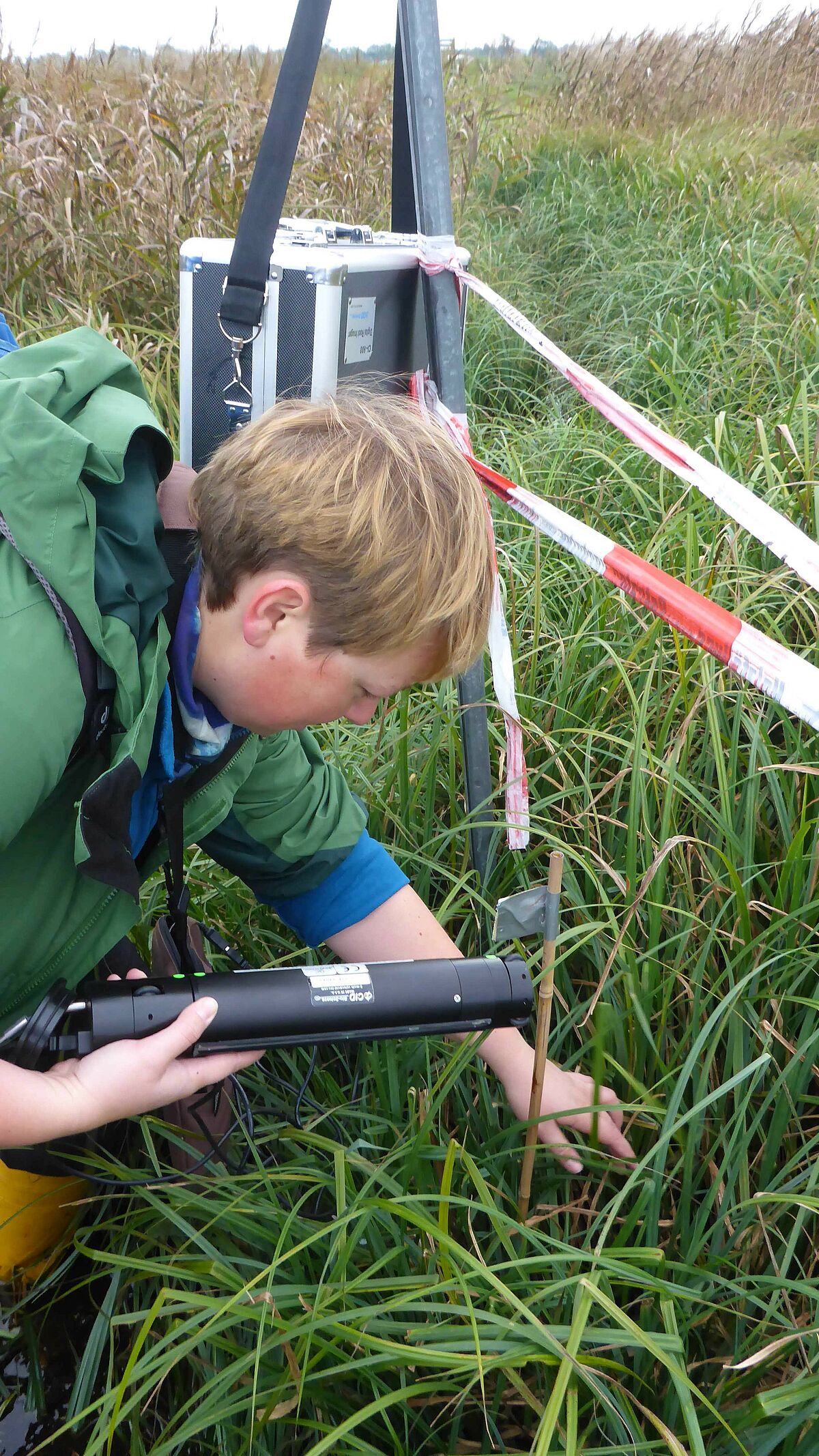
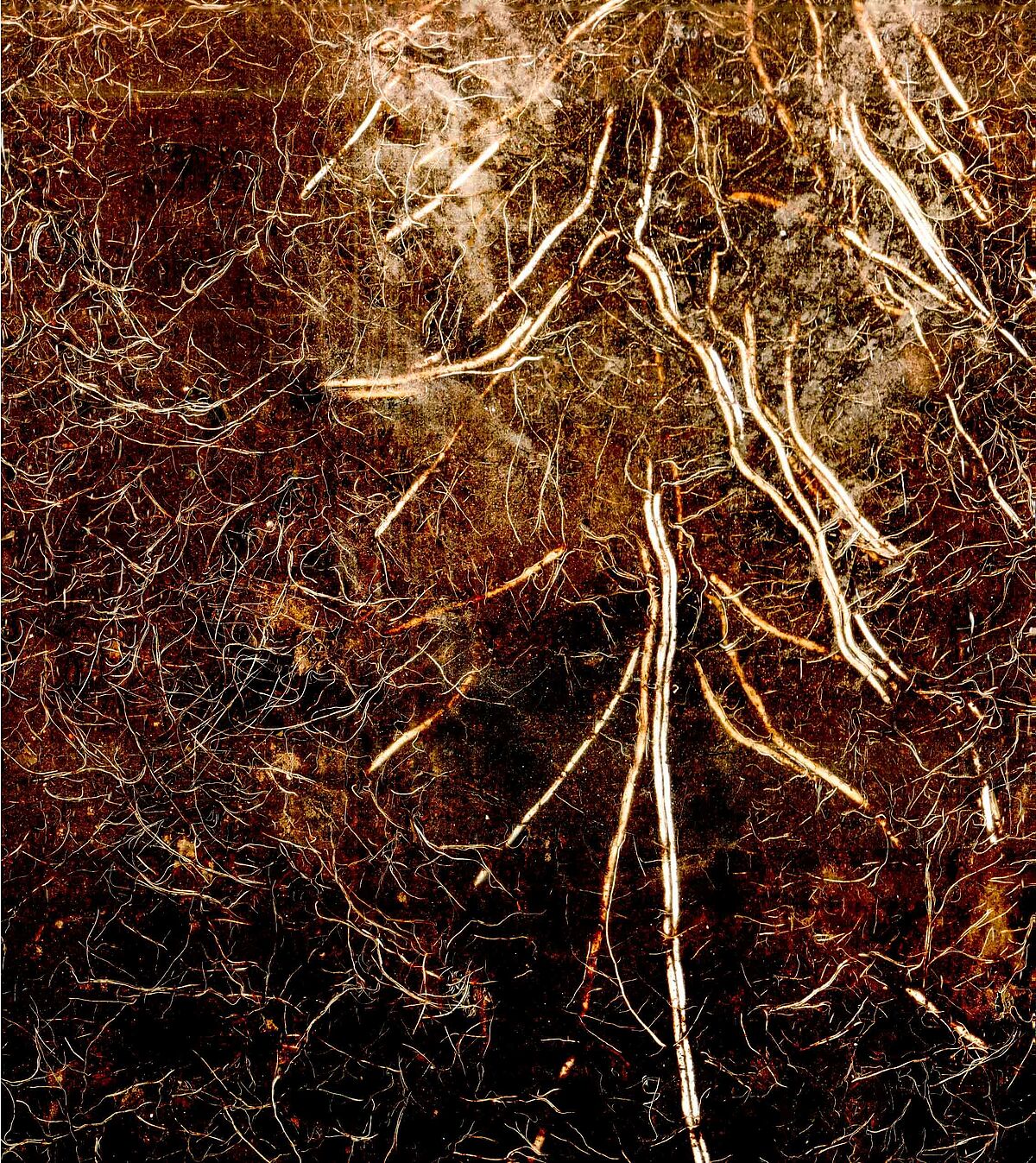
Timing: second half of 2023
Contact: Bo Peters & Jürgen Kreyling
Location: Greifswald
Peatlands are globally important carbon sinks, but drainage of peatlands leads to a release of the stored carbon and to large emission of greenhouse gases. To reduce greenhouse gas emissions, efforts are made in rewetting these systems in the hope of restoring their potential as carbon stores.
Here, the root growth dynamics in three different types of drained and rewetted peatlands (alder carr, percolation mire and coastal mire) are assessed by the minirhozotron technique. The same observations occurred already in the extremely dry and warm years 2018 and 2019 and 2020, when water tables even in the rewetted fens dropped below -60 cm. According to the IPCC report (2013), these extreme weather conditions are projected to increase with climate change. Long-term observations of root dynamics in drained and rewetted peatlands will increase our knowledge on how these ecosystems might react to changes in climate and if they are able to maintain their important function as carbon sinks in the future. This project is within the framework of WETSCAPES (www.wetscapes.uni-rostock.de).
Methods: Using minirhizotrons (root cameras), root growth in space and time is analysed at drained and rewetted peatlands in MV, which will be visited monthly during the growing season. A driving license is needed and an own car is a merit (travel costs will be covered).
Adaptation of forest trees to climate change (BA/MA)
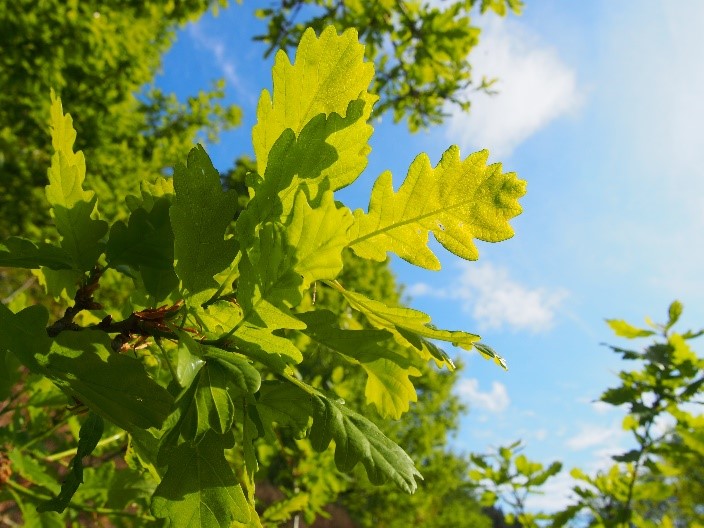
Time schedule:
Flexible, no fieldwork required
Contacts:
Alessandro Di Fabio (alessandro.difabio@uni-greifswald.de)
Prof. Dr. Jürgen Kreyling (juergen.kreyling@uni-greifswald.de)
Background:
Climate change is already impacting important forest tree species. As long-lived trees cannot shift their distribution ranges quickly, in-situ acclimation to changing climatic conditions will play a significant role in the future of European forests.
By using data from provenance trials established in warmer climates, we aim to identify tree species and populations which may be better able to adapt to the climate of the future.
This research is part of the EVA project (Evidence-based cultivation recommendations in climate change), and will provide important insights on the potential for valuable tree species to adapt to climate change via phenotypic plasticity.
Both bachelor and master thesis positions are available, with varying workloads.
Topic: Plasticity of Leaf Functional Traits
Phenology (the timing of leaf growth and fall) plays an important part in the adaptation to the local climatic condition for trees. The timing of leaf flushing is often given by the balance between the advantage earlier bud-burst and the danger of a late spring frost.
At the same time, plants strike a balance in leaf size and thickness: bigger leaves mean more sunlight is captured, but smaller leaves with thicker cuticles help retain water in drought conditions.
We will study how these functional traits vary across different populations in response to climate conditions.
Methods:
Depending on the thesis type, more or fewer of the following analyses will be carried out:
- Phenology will be measured by analysing images produced by cameras installed at the trial locations, using a Machine Learning algorithm;
- Growth performance will be quantified by analysing dendrometer data and tree height measurements;
- Leaf area and Specific Leaf Area will be measured from scans obtained during past fieldwork campaigns;
- Long-term climate data and data from local weather sensors is available, to correlate growth with climate and leaf functional traits.
Effects of Drought on Tree Growth
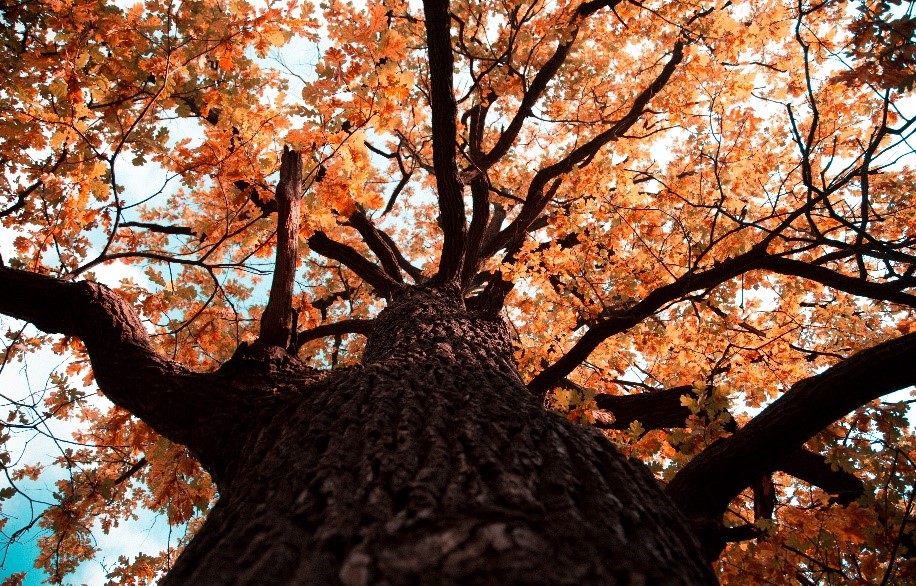
Time schedule:
Flexible, no fieldwork required
Contacts:
Alessandro Di Fabio (alessandro.difabio@uni-greifswald.de)
Prof. Dr. Jürgen Kreyling (juergen.kreyling@uni-greifswald.de)
Background:
Climate change is already impacting important forest tree species. As long-lived trees cannot shift their distribution ranges quickly, in-situ acclimation to changing climatic conditions will play a significant role in the future of European forests.
By using data from provenance trials established in warmer climates, we aim to identify tree species and populations which may be better able to adapt to the climate of the future.
This research is part of the EVA project (Evidence-based cultivation recommendations in climate change), and will provide important insights on the potential for valuable tree species to adapt to climate change via phenotypic plasticity.
Both bachelor and master thesis positions are available, with varying workloads.
Topic: Effects of Drought on Tree Growth
Trees react to drought conditions by reducing transpiration, increasing their water use efficiency, and this in turn affects the ratios of stable isotopes fixed by photosynthesis. By measuring the isotopic content of the tree tissues, we can indirectly measure how intensely the tree was water-stressed during the growing season.
In contrast with this indirect water stress measure, which averages the conditions over the entire growing season, dendrometers allow to measure the daily fluctuations in water content and tree growth. Using this high-resolution data allows to have a direct insight into how the climate conditions at the site determine the water stress of the trees.
We will study the differences in water stresses experienced by different tree species and populations in different trial sites, and how they correlate with the growth performance of the trees.
Methods:
Depending on the thesis type, more or fewer of the following analyses will be carried out:
- Drought intensity will be quantified by analysing data on leaf isotopic composition (13C, 18O, 15N), and by measuring the tree water deficit shown by dendrometer data;
- Growth performance will be quantified by analysing dendrometer data and tree height measurements;
- Long-term climate data and data from local weather sensors is available, to correlate growth with climate conditions.
Root exudation in Carex spec
Timetable: Earliest start: Mid-February to March 2024; Latest finalization July/ August 2024
Contact: Dr. Anna Roschanski, Prof. Dr. Juergen Kreyling
Background: Root exudates are soluble, low molecular weight organic compounds that are released to the soil by living plant roots (Meier et al. 2020). They are believed to play a role for the so-called priming effect (Kuzyakov 2010), i. e. the increase in soil organic carbon (SOC) decomposition rate after fresh organic matter input to soil (Fontaine et al. 2003). In peatlands SOC decomposition is restricted because of anoxic conditions, low pH and nutrient limitations (Mastný et al. 2021). Thus, root exudates are likely to influence the carbon cycle in peatland ecosystems. However, the extend of the influence is unknown as well the factors on which root exudation depends.
Methods: In a preparative experiment, we want to grow clones of Carex spec in pots under semi controlled condition, i. e. in a green house with controlled water supply, standardized soil (or hydroponic) nutrient content but natural light and temperature conditions. We will test different methods of exudate capture (e.g. using nutrient solutions or deionized water). Exudates will be compared with respect to their content of dissolved organic carbon (DOC) Research questions may be: Does drought effect root exudation? Does nitrate content effect root exudation? What is the effect of pH?
Meier, I.C., Tückmantel, T., Heitkötter, J., Müller, K., Preusser, S., Wrobel, T.J., Kandeler, E., Marschner, B. and Leuschner, C. (2020), Root exudation of mature beech forests across a nutrient availability gradient: the role of root morphology and fungal activity. New Phytol, 226: 583-594. https://doi.org/10.1111/nph.16389
Sébastien Fontaine, André Mariotti, Luc Abbadie (2003) The priming effect of organic matter: a question of microbial competition? Soil Biology and Biochemistry, 35, 6, 837-843, https://doi.org/10.1016/S0038-0717(03)00123-8
Yakov Kuzyakov (2010), Priming effects: Interactions between living and dead organic matter, Soil Biology and Biochemistry, 42, 9, 1363-1371, ISSN 0038-0717 https://doi.org/10.1016/j.soilbio.2010.04.003
Mastný, J., Bárta, J., Kaštovská, E. et al. Decomposition of peatland DOC affected by root exudates is driven by specific r and K strategic bacterial taxa. Sci Rep11, 18677 (2021). https://doi.org/10.1038/s41598-021-97698-2
Laufende und abgeschlossene Abschlussarbeiten:
2023
Transporation von Typha und auf eine Paludikultur-Pilotfläche (Bachelorarbeit betreut von Jürgen Kreyling)
How does flowering, flowe sart and flower duration influence the growth of subarctic dwarf shrubs, graminoids and herbs (Bachelorarbeit betreut von Jürgen Kreyling)
Der Einfluss der klimatischen Veränderung im Winter auf die Nährstoffverfügbarkeit und die mikrobiologische Aktivität im temperaten Buchenwald (Bachelorarbeit betreut von Jürgen Kreyling)
Individual diffrences in autumn phenology of Fagus sylcatica (L.) (Bacherlorarbeit betreut von Jürgen Kreyling)
2022
Vegetation development on a paludiculture site after two years of thyha cultivation
(Bachelorarbeit betreut von Jürgen Kreyling)
Auswirkungen von Trockenstress auf das Wachstum von Phragmites australis zweier verschiedener Ploidiestufen
(Masterarbeit betreut von Kerstin Haldan und Jürgen Kreyling)
Generationsübergreifende individuelle Unterschiede in der Phänologie bei Fagus sylvatica (L.)
(Bachelorarbeit betreut von Ilka Beil und Jürgen Kreyling)
UAV-Fernerkundung der Resilienz und Resistenz einer Küstendünenheide
(Bachelorarbeit betreut von Jürgen Kreyling)
Heritability of frost hardiness in European beech (Fagues sylvatica L.)
(Bachelorarbeit betreut von Jürgen Kreyling)
The effect of mycorrhizal associations and vegetation cover of litter decomposition in subarctic tundra
(Bachelorarbeit betreut von Jürgen Kreyling)
Paludikultur trotz Trockenheit? - Reaktion unterirdischer Biomasse von polyploiden Schilfklonen auf einen Dürregradienten
(Bachelorarbeit betreut von Jürgen Kreyling)
Predicting biomass production of Typha spec. on a rewetted paludiculture site over time using multitemporal and multispectral UAV data
(Masterarbeit betreut von Jürgen Kreyling)
Vegetation and site conditions of reweted fens in Central Europe
(Masterarbeit betreut von Jürgen Kreyling)
2021
Paludikultur trotz Trockenheit? - Reaktion unterirdischer Biomasse von polyploiden Schilfklonen auf einen Dürregradienten
(B.Sc. Arbeit, btreut durch Jürgen Kreyling und Kerstin Haldan)
Predicting biomass production of Typha spec. on a rewetted paludiculture site over time using multitemporal and multispectral UAV data
(M.Sc. Arbeit, betreut durch Jürgen Kreyling und Sebastian van der Linden)
Auswirkungen von Renaturierung auf die unterirdische Biomassebildung in Niedermooren
(B.Sc. Arbeit, betreut durch Jürgen Kreyling und Sarah Schwieger)
Das Wurzelwachstum von Moopflanzen im Frühjahr unter Einfluss verschiedener Wasserstände
(B.Sc.-Arbeit, betreut durch Jürgen Kreyling und Bo Peters)
Effects of drought on the growth of tera- and octoploid clones of Phragmites australis in a gradient experiment
(B.Sc.-Arbeit, betreut durch Jürgen Kreyling & Kerstin Haldan)
Einfluss der Schneebedeckung auf die Frosthärte von Vaccinium myrtillus und Vaccinium vitisidaea
(B.Sc.-Arbeit, betreut durch Jürgen Kreyling)
Dürresimulation in der Küstenheide - Ermittlung der Ursachen für das Ausbleiben eines Dürreeffekts auf Heidepflanzen
(B.Sc.-Arbeit, betreut durch Jürgen Kreyling & Irmgard Blindow)
Die Quantifizierung von Wurzelexudaten und der Link zu ober- und unterirdischer Aktivität von Niedermoorpflanzen
(M.Sc.-Arbeit, betreut durch Jürgen Kreyling & Nicole Wrage-Mönnig)
Individuelle Unterschiede in der Frühjahrsphänologie und deren Vererbbarkeit bei Fagus sylvativa (L.)
(B.Sc.-Arbeit, betreut durch Jürgen Kreyling & Jonas Schmeddes)
Autumnal root phenology of wetland plants under different water regimes
(B.Sc.-Arbeit, betreut durch Jürgen Kreyling & Bo Peters)
Influence of Vegetation COver and Mychorrizal Types on Litter Decomposition in Arctic Heath Vegetation Soil. A Tea Bag Study.
(B.Sc.-Arbeit, betreut durch Gesche Blume-Werry & Konstantin Gavazov)
Comparing decomposition in drained and rewetted peatlands: the effect of depth, fen ecosystem and litter type
(M.Sc.-Arbeit, betreut durch Gesche Blume-Werry & Sarah Schwieger)
Autumn phenology of roots in temperate fens
(M.Sc.-Arbeit, betreut durch Jürgen Kreyling & Bo Peters)
2020
Drought tolerance of tetra- and octoploid clones of Phragmites australis in a gradient experiment
(M.Sc.-Arbeit, betreut durch Jürgen Kreyling und Kerstin Haldan)
The ecological role of microbes in the digestive process of Nepenthes hemsleyana & N. rafflesiana
(M.Sc.-Arbeit, betreut durch Michael Schöner und Jürgen Kreyling)
Impacts of environmental factors and cultivation parameters on the establishment of Typha latifolia and T. angustifolia at a paludiculture site
(M.Sc.-Arbeit, betreut durch Josephine Neubert und Jürgen Kreyling)
Wasser, Konkurrenz und Temperatur als Treiber für ober- und unterirdisches Wachstum von Moorpflanzen im Frühling
(B.Sc.-Arbeit, betreut durch Jürgen Kreyling und Gesche Blume-Werry)
Root phenology on three different fen types in drained and rewetted conditions
(M.Sc.-Arbeit, betreut durch Jürgen Kreyling und Sarah Schwieger)
Kurzfristige Wurzelwachstumsdynamik in täglicher Auflösung bei varriierenden Wasserständen in Niedermooren
(B.Sc.-Arbeit, betreut durch Jürgen Kreyling und Gesche Blume-Werry)
Das Wachstum der unterirdischen Biomasse der Rohrkolbenarten Typha latifolia und Typha angustifolia entlang von Gradienten der Nährstoffverfügbarkeit und des Wasserstandes
(B.Sc.-Arbeit, betreut durch Kerstin Haldan und Jürgen Kreyling)
Are phenological leaf traits of mother trees and their offsprings' timing of germination correlated in Fagus sylvatica?
(B.Sc.- Arbeit, betreut durch Jürgen Kreyling und Jonas Schmeddes)
Wurzel- und Rhizomwachstum verschiedener Genotypen von Phragmites australis entlang eines Wasserstandsgradienten
(B.Sc.-Arbeit, betreut durch Jürgen Kreyling und Kerstin Haldan)
Wie tief schlafen Bäume wirklich? - Verlauf der Wurzeldormanz im Vergleich zur Knospendormanz
(B.Sc. Arbeit, betreut durch Andrey Malyshev und Gesche Blume-Werry)
Root porosities of Phragmites australis clones differ along artificial water and nutrient gradients
(M.Sc. Arbeit, betreut durch Jürgen Kreyling und Kerstin Haldan)
Die specific root length (SRL) von Phragmites australis entlang eines Nährstoffgradienten in einem Mesokosmenexperiment
(B.Sc. Arbeit, betreut durch Kerstin Haldan und Jürgen Kreyling)
The effect of frost on the photosynthetic activity of winter reapeseed (Brassica napus) during a mild winter
(B.Sc. Arbeit, betreut durch Ilka Beil und Jürgen Kreyling)
Specific Root Length variation of Phragmites australis clones in response to different water levels
(B.Sc. Arbeit, betreut durch Jürgen Kreyling und Kerstin Haldan)
Frühjahrsphänologie von Fagus sylvatica L. unter Dürrebedingungen und unter Betrachtung verschiedener Herkünfte
(B.Sc. Arbeit, betreut durch Ilka Beil und Andrey Malyshev)
Trockenheitsschäden an Calluna vulgaris und deren Erholung in der Küstendünenheide von Hiddensee, erfasst durch wiederholte Drohnenbefliegung
(B.Sc. Arbeit, betreut durch Jürgen Kreyling und Tobias Dahms)
Quantifying phenotypic plasticity of Fagus sylvatica in a reciprocal transplantation experiment across a Europe-wide gradient
(M.Sc. Arbeit, betreut durch Jürgen Kreyling und Jonas Schmeddes)
Untersuchungen über die Auswirkungen verschiedener Wasserlevel und Nährstofflevel auf das Blatt- und Sprosswachstum bei fünf verschiedenen Klonen von Phragmites australis
(B.Sc. Arbeit, betreut durch Jürgen Kreyling und Kerstin Haldan)
Die Brutvögel des Strandwallfächers auf de Insel Hiddensee
(BSc-Arbeit, Betreuer: Irmgard Blindow & Angela Schmitz-Ornes)
Untersuchungen zu Beziehungen zwischen höheren Pflanzen und Standortfaktoren im Strandwallfächer und auf der Glambäkwiese auf de Insel Hiddensee
(BSc-Arbeit, Betreuer: Irmgard Blindow & Heike Ringel)
Brutvögel im Dornbusch auf der Insel Hiddensee - Zusammenhang mit zunehmender Verbuschung
(BSc-Arbeit, Betreuer: Angela Schmitz & Irmgard Blindow)
Die Grabwespenfauna der Insel Hiddensee - Veränderungen über fünf Jahrzehnte
(BSc-Arbeit, Betreuer: Irmgard Blindow & Christian Schmid-Egger)
Recovery of a coastal heathland after disturbance – does drought matter?
(BSc-Arbeit, Betreuer: Jürgen Kreyling und Ilka Beil)
2019
Zusammenhang von Frostresistenz und Zeitpunkt des Austriebs bei Gehöölzen im Greifswalder Arboretum
(B.Sc.-Arbeit, betreut durch Ilka Beil und Jürgen Kreyling)
Photosynthesis rates in five clones of Phragmites australis in a water and a nutrient gradient experiment
(M.Sc.-Arbeit, betreut durch Jürgen Kreyling und Kerstin Haldan)
Importance of snow cover for understory plants in boreal forests
(B.Sc.-Arbeit, betreut durch Jürgen Kreyling und Gesche Blume-Werry)
Einfluss der Temperatur auf die Dormanztiefe und Frühlingsphänologie bei vier verschiedenen Laubbaumarten
(B.Sc.-Arbeit, betreut durch Jürgen Kreyling und Ilka Beil)
Development of root distribution patterns of Andean Lupin (Lupinus mutabilis) in monoculture and intercropped with maize
(M.Sc.-Arbeit, betreut durch Jürgen Kreyling und Herr Dr. Böhm)
Effects of snow cover on fine root growth in beech forest varying in winter harshness
(B.Sc.-Arbeit, betreut durch Robert Weigel und Juergen Kreyling)
Putting the root growth of an extreme year into perspective
(M.Sc.-Arbeit, betreut durch Gesche Blume-Werry und Sarah Schwieger)
Digital visualization of roots in peat
(M.Sc.-Arbeit, betreut durch John Couwenberg und Gesche Blume-Werry)
Comparison of root growth within and among five Carex species, influenced by nutrient levels
(M.Sc.-Arbeit, betreut durch Gesche Blume-Werry und Juergen Kreyling)
Influence of water regime on root production of wetland plants
( B.Sc.-Arbeit, betreut durch Gesche Blume-Werry und Juergen Kreyling)
The influence of aspect on species composition and phenology at mountain summits of Nuolja and Slåttajakka, Sweden
(B.Sc.-Arbeit, betreut durch Gesche Blume-Werry und Keith Larsen)
Changes in vegetation composition in the last 100 years on Mount Nuolja, northern Sweden
(B.Sc.-Arbeit, betreut druch Gesche Blume-Werry und Keith Larsen)
Einflussfaktoren auf die Blühphänologie von Anemone Nemorosa
(B.Sc.-Arbeit, betreut durch Jürgen Kreyling und Jonas Schmeddes)
Zusammenhang von Baumbeschaffenheit und Zeitpunkt des Austriebs bei etwa 500 Baum- und Straucharten im Greifswalder Arboretum
(B.Sc.-Arbeit, betreut durch Jürgen Kreyling und Ilka Beil)
Assessing root production in drained and re-wetted peatlands
(B.Sc.-Arbeit, betreut durch Jürgen Kreyling und Sarah Schwieger)
Influence of temperature on autumnal phenology in trees
(B.Sc.-Arbeit, betreut durch Jürgen Kreyling und Ilka Beil)
Age and biomass distribution of Alnus glutinosa roots in a drained and a rewetted Swamp
(M.Sc.-Arbeit, betreut durch Frau Dr. Anadon-Rosell und Sarah Schwieger)
Abbau organischen Materials in trockenen und wiedervernässten Mooren
(B.Sc.-Arbeit, betreut durch Sarah Schwieger und Gesche Blume-Werry)
Einfluss der landwirtschaftlichen Nutzung auf das Vorkommen von Amphibien in Kleingewässern Rügens
(MSc-Arbeit, Betreuer: Falk Ortlieb & Irmgard Blindow)
Einfluss der landwirtschaftlichen Nutzung auf das Vorkommen von Wasserpflanzen in Kleingewässern auf Rügen
(MSc-Arbeit, Betreuer: Irmgard Blindow & Hendrik Schubert)
Der Einfluss von Makrophyten auf Makrozoobenthos in zwei flachen Küstengewässern der Ostsee
(BSc-Arbeit, Betreuer: Martin Paar & Irmgard Blindow)
Feeding behaviour of the marine gastropod Aplysia dactylomela under elevated temperatures
(MSc-Arbeit, Betreuer: Mark Lenz & Irmgard Blindow)
Einfluss unterschiedlicher Habitatqualität auf die Nahrungsökologie und den Bruterfolg des Braunkehlchens (Saxicola rubetra)
(BSc-Arbeit, Betreuer: Irmgard Blindow & Hermann Hötker)
2018
Minirhizotron picture analysis - maintaining accuracy while reducing time effort
(B.Sc.-Arbeit betreut durch Gesche Blume-Werry und Robert Weigel)
Einfluss von Trockenheit und Beweidung auf die Entwicklung der Heide auf Hiddensee
(B.Sc.-Arbeit, betreut durch Ilka Beil und Jürgen Kreyling)
Management options for the conversion of non-native coniferous forest patches towards more natural species composition in the Western Pomerania Lagoon Area National Park (Germany)
(Masterarbeit, betreut durch Juergen Kreyling und Michael Manthey)
Do volcanoes fertilize the globe?
(Bachelorarbeit, betreut durch Juergen Kreyling und Ilka Beil)
Frost and drought tolerance in two provenances of a temperate weed (Anchusa arvensis)
(Bachelorarbeit, betreut durch Andrey Malyshev)
Cross-stress memory: Influence of prior frost exposure on drought tolerance of a temperate weed
(Bachelorarbeit, betreut durch Andrey Malyshev)
Variation der Frühjahrsphänologie bei Rotbuchen (Fagus sylvatica L.) unter Betrachtung der innerartlichen Konkurrenz
(Bachelorarbeit, betreut durch Juergen Kreyling & Ernst van der Maaten)
Inter-individual variation in spring phenology of european beech
(Bachelorarbeit, betreut durch Juergen Kreyling & Andrey Malyshev)
Effects of manipulated snow cover on fine root growth in beech forests varying in winter harschness
(Bachelorarbeit, betreut durch Robert Weigel & Juergen Kreyling)
Möglicher Zusammenhang zwischen Elektrolytgehalt und Tiefe der Knospendormanz
(Bachelorarbeit, betreut durch Andrey Malyshev)
Conditionally expressed heritability in Fagus sylvatica in a translocation experiment across Europe
( Masterarbeit, betreut durch Juergen Kreyling & Lena Muffler)
Chasing aliens: The effects of non-native species removal on early stages of tallgrass prairie restoration
(Bachelorarbeit, betreut durch Hugh AL Henry & Juergen Kreyling)
Stressgedächtnis und lokale Anpassung verschiedener Herkünfte der Rotbuche (Fagus sylvatica L.) an Frost
(Bachelorarbeit, betreut durch Juergen Kreyling)
Temperature dependence of heritability in Arabidopsis thaliana
(Masterarbeit, betreut durch Juergen Kreyling)
Using historical and phenological data to explain spatial and temporal variation in spring budburst dates of five tree species in Germany
(Masterarbeit, betreut durch Andrey Malyshev)
Untersuchung der Zersetzung in trockengelegten und wiedervernässten Mooren mit dem Tea Bag Index
(Bachelorarbeit, betreut durch Jürgen Kreyling & Sarah Schwieger)
Structure and migration behaviour of zooplankton in the lagoons of the southern Baltic Sea
(MSc-Arbeit, Betreuer: Irmgard Blindow, Rhena Schumann)
Nährstofflimitation des Phytoplanktons in Boddengewässern Mecklenburg-Vorpommerns
(MSc-Arbeit, Betreuer: Max Berthold, Irmgard Blindow)
Impacts of eutrophication on growth of the European perch Perca fluviatilis (Linnaeus 1758) in brackish coastal lagoons of the Baltic Sea
(MSc-Arbeit, Betreuer: Hendrik Schubert, Martin Paar)
2017
Effects of snow cover on fine root growth in beech forests varying in winter harshness
(Bachelorarbeit, betreut durch Robert Weigel)
Memory effects and intraspecific variation in stress response of Fagus sylvatica to recurrent drought events
(Bachelorarbeit, betreut durch Jürgen Kreyling)
Cross-stress tolerance and stress memory in perennial plants
(Bachelorarbeit, betreut durch Andrey Malyshev)
Bud dormancy and frost tolerance in trees – are they linked?
(Masterarbeit, betreut durch Andrey Malyshev)
Die Auswirkungen verschiedener Winterbedingungen auf die Knospenzruhe und Knospenfrosthärte bei Fagus sylvatica
(Bachelorarbeit, betreut durch Jürgen Kreyling)
Root- and shoot phenology in different vegetation types
(Masterarbeit, betreut durch Gesche Blume-Werry und Juergen Kreyling)
Influence of warm temperature on growth and development of Arabidopsis thaliana
(Bachelorarbeit, betreut durch Jürgen Kreyling und Ilka Beil)
Impacts of machine mowing on selected soil properties of near-natural fens - A case study from NE Germany
(Masterarbeit, betreut durch Franziska Tanneberger und Juergen Kreyling)
Impacts of machine mowing on vegetation composition, root porosity and decomposition in near-natural fens - A case study from NE Germany
(Masterarbeit, betreut durch Elke Seeber und Juergen Kreyling)
Response of a coastal heathland to drought and grazing during different successional stages
(Bachelorarbeit, betreut durch Ilka Beil und Juergen Kreyling)
Importance of the three-spined stickleback (Gastrerosteus aculeatus) in the food web of two coastal shallow lagoons in the southern Baltic Sea
(Masterarbeit, betreut durch Irmgard Blindow)
Effects of snow cover on fine root growth in beech forests varying in winter harshness
(Bachelorarbeit, betreut durch Robert Weigel und Jürgen Kreyling)
Within-species variation in leaf traits of Fagus sylvatica in response to macroclimatic site conditions
(Bachelorarbeit, betreut durch Lena Muffler und Jürgen Kreyling)
Leaf and growth traits in different populations of Fagus sylvatica in response to drought
(Masterarbeit, betreut durch Jürgen Kreyling und Lena Muffler)
Stressgedächtnis und lokale Anpassungsfähigkeit verschiedener Herkünfte der Rotbuche (Fagus sylvatica L.) an Spätfrost
(Bachelorarbeit, betreut durch Lena Muffler und Jürgen Kreyling)
Veränderungen der Waldbodenvegetation entlang eines Temperaturgradienten in Buchenwäldern an neun Standorten in Deutschland und Polen
(Masterarbeit, betreut durch Robert Weigel und Jürgen Kreyling)
Developement of bud dormancy and cold tolerance in species with different chilling requirements
(Diplomarbeit, betreut durch Andrey Malyshev)
Comparison of above ground and below ground autumn phenology in contrasting temperate vegetation types
(Masterarbeit, betreut durch Jürgen Kreyling und Robert Weigel)
2016
Bestimmung der flächendifferenzierten Grundwasserneubildung eines holozänen Porengrundwasserleiters auf Hiddensee (Mecklenbeck-Vorpommern)
(Bachelorarbeit, betreut durch Maria Schafmeister und Irmgard Blindow)
Kalkinkrustierung verschiedener Characeenarten in Süß- und Brackwasser
(Masterarbeit, betreut durch Irmgard Blindow)
Distribution of Zostera marina in the coastal waters of the Baltic Sea
(Masterarbeit, betreut durch Irmgard Blindow)
Der Einfluss meteorologischer Elemente auf das Blühverhalten ausgewählter Orchidaceae des Naturpark Schlaubetal
(Bachelorarbeit, betreut durch Jürgen Kreyling)
Influence of soil-borne pathogens on seedling performance in declining Quercus suber forests: an experimental approach
(Masterarbeit, betreut durch Jürgen Kreyling)
Temporal bud dormancy and cold tolerance changes in trees
(Bachelorarbeit, betreut durch Andrey Malyshev)
Populations-spezifische Frosttoleranz vor und nach der Keimung von Fagus sylvatica
(Bachelorarbeit, betreut durch Jürgen Kreyling und Lena Muffler)
Allometric quantification of biomass in Calluna vulgaris
(Masterarbeit, betreut durch Jürgen Kreyling und Irmgard Blindow)
Fotoidentifikation von Meeresschildkröten auf Koh Tao, Thailand
(Bachelorarbeit, betreut durch Irmgard Blindow)
2015
Plant stress memory: effects of recurrent drought and frost events on stress resistance in P lanceolata
(Masterarbeit, betreut durch Andrey Malyshev)
Long term effects of a crude oil spill on desert vegetation
(Bachelorarbeit, betreut durch Jürgen Kreyling)
Effects of climate change induced autumnal warming on root phenology in the Arctic tundra
( Masterarbeit, betreut durch Jürgen Kreyling)
Zusammenhang zwischen frühlaichenden Amphibien und Habitateigenschaften von Kleingewässern auf der Insel Hiddensee
(Bachelorarbeit, betreut durch Irmgard Blindow)
Zusammenhang zwischen Gewässereigenschaften und Amphibien auf der Insel Hiddensee
(Masterarbeit, betreut durch Irmgard Blindow)
Beziehungen zwischen Zooplankton und submersen Makrophyten in der Darß-Zingster Boddenkette
(Masterarbeit, betreut durch Irmgard Blindow)
Sedimentation und Resuspension in der Darß-Zingster Boddenkette – eine Methodenstudie
(Masterarbeit, betreut durch Irmgard Blindow)
Composition and adaptation of submerged macrophytes in shallow coastal lagoons of the southern Baltic Sea
(Masterarbeit, betreut durch Irmgard Blindow)
2014
Interaktionen zwischen suspendiertem Material und submersen Makrophyten in flachen Küstengewässern der südlichen und westlichen Ostsee
(Diplomarbeit, betreut durch Irmgard Blindow)
Zusammenhang zwischen Makrophytobenthos und Sedimentstruktur in flachen Küstengewässern der deutschen Ostsee
(Diplomarbeit, betreut durch Irmgard Blindow)
Wechselwirkungen zwischen Phytoplankton, Nährstoffen und Submersvegetation an der deutschen Ostseeküste
(Diplomarbeit, betreut durch Irmgard Blindow)
Interaktionen zwischen Zooplankton und submersen Makrophyten in den Boddengewässern vor Hiddensee
(Diplomarbeit, betreut durch Irmgard Blindow)
Potential und aktueller Stand der Kultivierung von Dreissena polymorpha zur Verbesserung des ökologischen Zustandes des Usedomer Sees
(Masterarbeit, betreut durch Sven Dahlke)
Aktuelle Situation submeser Makrophyten und Diasporenreservoir im Usedomer See
(Diplomarbeit, betreut durch Sven Dahlke)
Means of communication and herbicide effects in predator-prey interactions between Scorpaena porcus and Pomatoschistus spp.
(Diplomarbeit, betreut durch Claudia Kruschel und Irmgard Blindow)
Bereitstellungsketten von Landschaftspflegematerial zur energetischen Nutzung am Beispiel der Insel Hiddensee
(Bachelorarbeit (FH Stralsund), betreut durch Irmgard Blindow)
